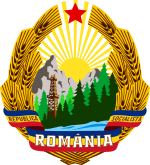SovRom
| Part of a series on the |
| Socialist Republic of Romania |
|---|
 |
The SovRoms (plural of SovRom) were economic enterprises established in Romania following the communist takeover at the end of World War II, in place until 1954–1956 (when they were dissolved by the Romanian authorities).
In theory, SovRoms were joint Romanian-Soviet ventures aimed at generating revenue for reconstruction,
History
Creation, structure, and effects

An agreement between the two countries regarding the establishment of common enterprises was signed in Moscow on May 8, 1945,[6] at a time when Romania found itself in economic isolation.[7]
The first SovRom to be created (on July 17, 1945), was Sovrompetrol, which had as its objective the exploitation of petroleum in Prahova County areas and the oil refineries in Ploiești.[8] By 1947, it was responsible for 37% of oil drilling,[7] some 30% of the total production of crude oil, and over 36% of refined oil,[7] controlling 37% of internal oil supplies and 38% of external ones.[7]
Sovrompetrol was followed by Sovromtransport and Tars (transportation), and later by Sovrombanc (
).Most notoriously, Sovromcuarț (or Sovromquarțit, Sovrom Kvartit), while ostensibly producing
By 1952, 85% of Romanian export was directed at the Soviet Union.[18] The total value of goods[specify] passed by Romania to the Soviet Union surpassed by far the demanded war reparations, being estimated at 2 billion dollars.[19]
Special circumstances also enhanced the negative effects of SovRoms on
Ending
The SovRoms' end, evidence of the relative emancipation of the
Discussions aimed at winding down the SovRoms began in March 1953.[23] The first measure was taken in 1954 (through accords signed in March and September):[7] Soviet shares in 12 of the 16 enterprises were taken over by the Romanian state, in exchange for a sum to be paid in installments of merchandise exports (in 1959, the debt was set at over 35 billion lei).[24] Payments were completed in 1975.[24] The initial sum at which the Soviet side estimated its contribution was 9.6 billion lei, in contrast to the 2.9 billion lei at which it had been valued by Romanian sources;[25] discussions on the matter reduced the sum to a total of 5.3 billion lei, which was construed by the two sides not as a corrected result, but as a concession owing to past irregularities in SovRom activities.[25] At the same time, the Soviet Union announced that it gave up interests in formerly German-owned enterprises and equipment on Romanian soil, for which Romania paid 1.5 billion lei as compensation (deducted from the total 5.3 billion).[25]
The last two remaining SovRoms, Sovrompetrol and Sovromcuarț, were disbanded in 1956.[26] However, the Romanian government signed an agreement that would replace Sovromcuarț with a new state-owned company which was to carry on the mining and processing of uranium ore, delivering its entire output to the Soviet Union.[27] This successor company was itself dissolved in 1961.[17] Soviet investment in Sovromcuarț was evaluated to a debt of 413 million rubles, which were to be paid by Romania over a 10-year period (starting with 1961).[28]
The gesture was used by
See also
Notes
- ^ Cioroianu, p.68, 70
- ^ Rîjnoveanu, p.1
- ^ Cioroianu, p.68, 71, 73; Rîjnoveanu, p.1
- ^ Cioroianu, p.73
- ^ Alexandrescu, p.40-41
- ^ Alexandrescu, p.39; Rîjnoveanu, p.1
- ^ a b c d e Alexandrescu, p.39
- ^ Cioroianu, p.68
- ^ Alexandrescu, p.39-40; Cioroianu, p.69-70
- ^ Banu, p.28-29; Cioroianu, p.70
- ^ Khrushchev, p. 720
- ^ Guță, Daniel (April 18, 2023). "Dosarele X din orașul-fantomă al uraniului. Experiența paranormală trăită de un român în adâncuri". Adevărul (in Romanian). Retrieved March 7, 2024.
- ^ Balint, Mario (August 24, 2016). "Epopeea uraniului bănățean de la exportul în URSS, în farfurie" (in Romanian). Radio România Actualități. Retrieved March 7, 2024.
- ^ Banu, p.29; Cioroianu, p.70
- ^ Banu, p.30
- ^ Cioroianu, p.70
- ^ a b c Diehl
- ^ Cioroianu, p.372-373
- ^ Roper, p.18
- ^ Cioroianu, p.71-72
- ^ Cioroianu, p.72-74
- ^ Cioroianu, p.208
- ^ Țiu
- ^ a b Alexandrescu, p.40
- ^ a b c Alexandrescu, p.41
- ^ Banu, p. 31; Rîjnoveanu, p.1
- ^ Banu, p. 31; Diehl
- ^ Banu, p.29
- ^ Roper, p.22
- ^ Cioroianu, p.71, 74-76; Rîjnoveanu, p.1
References
- "Soviet-Rumanian Relation in the Light of Recent Events in Hungary and Poland", November 1956, at the Blinken Open Society Archives
- Ion Alexandrescu, "1945-1956: Din «cleștele» German — în brațele «fratelui» de la răsărit. Societățile mixte sovieto-române (Sovrom)" ("1945-1956: From the German's «Tongs» — into the Eastern «Brother»'s Arms. Mixed Soviet-Romanian Societies (Sovrom)"), in Dosarele Istoriei, 3/1996
- Florian Banu, "Uraniu românesc pentru «marele frate»" ("Romanian Uranium for the «Big Brother»"), in Dosarele Istoriei, 9/2005
- ISBN 973-669-175-6
- Peter Diehl, "Uranium Mining in Europe", Chapter 1, 1995
- ISBN 0-271-02332-5
- Carmen Rîjnoveanu, "Romania's Policy of Autonomy in the Context of the Sino-Soviet Conflict", in NATO and the Warsaw Pact — The Formative Years 1948-1968, 2003 Conference comments and papers, Czech Republic Military History Institute, Militärgeschichtliches Forscheungamt
- Stephen D. Roper, Romania: The Unfinished Revolution, ISBN 90-5823-027-9
- (in Romanian) Ilarion Țiu, "Deputatul Ceaușescu a votat entuziast naționalizarea" ("Deputy Ceaușescu Enthusiastically Voted for Nationalization"), in Adevărul, September 16, 2011
External links
- (in Romanian) Grecu Dan, Salvate de la coșul de gunoi ("Rescued from the Garbage Bin") — SovRoms in postal history
